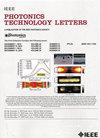Effect of P-Electrode Area Ratio on Micro-LED Optoelectronic Performance
IF 2.3
3区 工程技术
Q2 ENGINEERING, ELECTRICAL & ELECTRONIC
引用次数: 0
Abstract
The P-electrode is essential for achieving uniform current distribution within the chip, which directly affects the device optoelectronic performance. In this study, micro-LEDs of varying sizes (22, 34, andp -电极面积比对微型led光电性能的影响
p电极是实现芯片内电流均匀分布的关键,它直接影响器件的光电性能。在本研究中,制备并分析了不同尺寸(22、34和$46~ $ m)和p电极面积比(20%、30%和40%)的微型led。研究结果表明,在低电流密度条件下,小于$50~\mu $ m的微型led的光电性能受到p -电极面积比的显著影响。这种效应主要是由于电流分布和p电极金属的阻光特性的综合影响。为了表征这些微型led的性能,采用了高光谱成像和COMSOL模拟。从这些结果中获得的见解为低电流密度工作优化的微型led的设计和制造提供了有价值的指导。
本文章由计算机程序翻译,如有差异,请以英文原文为准。
求助全文
约1分钟内获得全文
求助全文
来源期刊

IEEE Photonics Technology Letters
工程技术-工程:电子与电气
CiteScore
5.00
自引率
3.80%
发文量
404
审稿时长
2.0 months
期刊介绍:
IEEE Photonics Technology Letters addresses all aspects of the IEEE Photonics Society Constitutional Field of Interest with emphasis on photonic/lightwave components and applications, laser physics and systems and laser/electro-optics technology. Examples of subject areas for the above areas of concentration are integrated optic and optoelectronic devices, high-power laser arrays (e.g. diode, CO2), free electron lasers, solid, state lasers, laser materials'' interactions and femtosecond laser techniques. The letters journal publishes engineering, applied physics and physics oriented papers. Emphasis is on rapid publication of timely manuscripts. A goal is to provide a focal point of quality engineering-oriented papers in the electro-optics field not found in other rapid-publication journals.
 求助内容:
求助内容: 应助结果提醒方式:
应助结果提醒方式:


